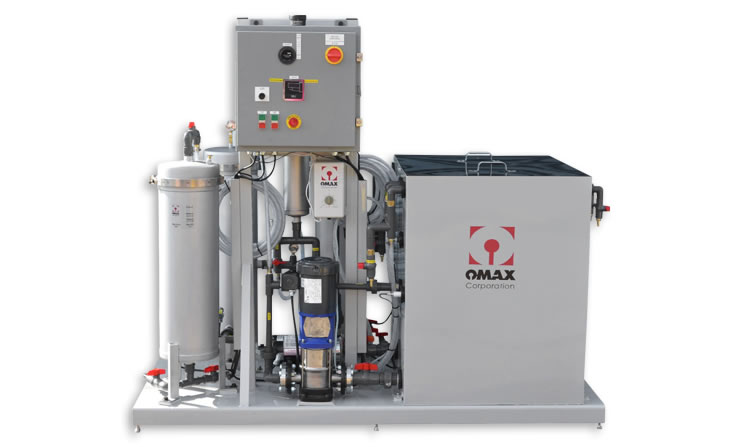
Many shop owners are concerned about the water consumption that abrasive waterjet cutting requires, and the process for properly disposing of the used water after cutting. One of the big advantages to abrasive waterjet cutting is that it’s such a “green” technology – no dangerous gases or chemicals are used. Abrasive comes for the ground and is generally able to go back to the ground, but what about the water supply – can it go back to the ground water? Generally the answer is yes. In most cutting operations spent water is considered standard grey water and can go right down the drain. Of course if the material being cut on the waterjet is hazardous, such as lead or copper, then those chemicals could be introduced in to the water supply and thus it should not go down the drain. However in general job shop operation or standard cutting the water is safe to go to the drain.
So why do people purchase closed loop water filtration systems? A closed loop water recycling system is an expensive investment which needs to be carefully considered and justified before being added to a waterjet purchase. There are several situations where one might be necessary. First if the shop is on a well rather than city water. In many cases the well water supply is not sufficient to keep up with the demand that the waterjet puts on it. Second if the shop uses a septic system for waste water disposal. Again the capacity of the septic tank will likely not be able to handle the volume of water that the cutting process will generate. Another reason would be if the materials being cut are going to be hazardous at which point a closed loop system will be a requirement. Lastly to reduce water consumption in general. While it may seem that adding a closed loop system would save money by reducing water consumption/disposal costs that is not typically the case. Generally the cost for the filters that the treatment system requires are more than the cost of water, but if the goal is not to save money but simply to reduce water usage than the closed loop system will do the job. Keep in mind that the water must be extremely clean in order to be put back through the pumping system hence the expensive filters.
Another factor to consider is how much water will be necessary to operate the waterjet. This will depend entirely on the type of pump that the abrasive waterjet is running off of. Generally in the industry there are two common options, the hydraulic intensifier pump and the direct drive crankshaft style pump. When considering a pump one significant difference between them is the water consumption. The intensifier pump will require substantially more incoming water and of course generate more waste water for disposal. While both pumps need about 1 gal/min of water for the actual cutting process, the intensifier pump will also need water to cool the hydraulic system. This cooling water will be an additional 4-6 gal/min depending on how warm the incoming water is and how hot the pump has gotten. An even larger water volume would be necessary for the larger horsepower hydraulic pumps. The direct drive pump does not generate anywhere near as much heat thus it’s able to use the same 1 gal/min to first do the necessary cooling and then be used for cutting. A larger number of shops running intensifier pumps will opt to add the water recycling system for the goal of reducing water consumption than those operating the direct drive pumps.
A water recycling system is definitely worth consideration when looking to purchase a waterjet however the high price point makes it less attractive for most customers who aren’t required to use it. Abrasive waterjet cutting is definitely an environmentally friendly operation whether a closed loop water filtration system is used or not.
